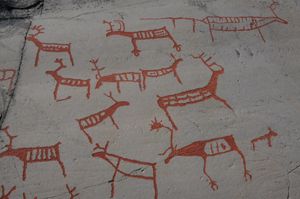About the project
Hunters’ rock art of Mesolithic and Early Neolithic age on the Scandinavian peninsula are the primary source material of this project. The study was accompanied with investigations of quarries and raw material use.
Meetings Make History aimed at making rock art a useful source material for investigations of the historical dynamics of Mesolithic northern Europe. An effort was made to make rock art the basis for studying developments in the ideology and sociology of Mesolithic societies through approaches connected to the concepts of animism and totemic. A methodology is modeled to discern animic and totemism figural elements.
Animism and totemism
Animism and totemism are regarded two main types of hunter-gatherer world views that are not mutually exclusive; however, specific contexts may be said to be dominated by either one.
On a general basis the Early Mesolithic on the Scandinavian peninsula is dominated by an animic world view, whereas the Late Mesolithic southern and northern Norway, clearly was dominated by totemism. Simultaneously, Sweden, especially with reference to the Nämforsen rock art site, seems to be dominated by animism. In the beginning of the Neolithic / Younger Stone Age, the rock art of northernmost Norway depicts a pure animic expression, and thus seems to be “back” within a world view dominated by animism.
Venues of great meetings
Differences in rock art styles between regions are seen to express local origins and local belonging of the meetings groups. Still, figural compositions appearing at rock art sites throughout the entire investigation area express some common “pan-nordic” beliefs that get their local expression. However, a few discernible figural elements – investigated as social markers – habitually appears in small numbers at rock art sites far away from their area of origin.
Thus, a core issue of the project was to approach rock art and rock art sites such like Vingen, western Norway, Alta, northern Norway and Nämforsen northern Sweden, as venues of great meetings between groups of different social belonging and landscapes. The social developments triggered by meetings, gift exchange, marriage and alliance were investigated as integral parts of the interregional and social / ideological developments during the Mesolithic.
Financing
Duration
01.09.2011-31.12.2014
Publications
- Fuglestvedt, Ingrid 2018: Rock Art and the Wild Mind. Visual Imagery in Mesolithic Northern Europe. London / New York: Routledge.
- Katalog til: Rock Art and the Wild Mind. Visual Imagery in Mesolithic Northern Europe. London / New York: Routledge.
- Fuglestvedt, I. 2019: The Mythical Mind of the Older Stone Age - a Lévi-Straussian Reappraisal. Time an Mind Vol. 12, Iss. 3, 187-195.
- Fuglestvedt, I. in press: The Mind in the Wild. On 'Motemic Variation' in Mesolithic Scandinavian Rock Art. In: Perspectives on Differences in Rock Art. London: Equinox.
- Fuglestvedt, I. in press: The Alta Rock Art displays Scenes of Human Control of Reindeer. An Event of Early Domestication in the far North? Current Swedish Archaeology.
